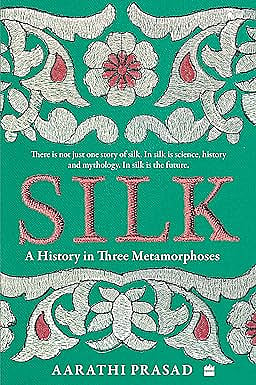Cocooned in Time

Everything you always wanted to know about the silkworm but were too shy to ask could well be the subtitle to Aarathi Prasad’s expertly spun cocoon on silk.
Yet that’s the least of it. In this three-part book of linked histories, Prasad has woven a tapestry of utmost delight and delicacy. It stretches into pre-history looking for spiders trapped in amber preserved by chance in the Kachin province of Burma, during an age when dinosaurs roamed the earth. She has dived deep into the Mediterranean littoral seeking a type of mollusc that sports a beard of fine filaments that can be harvested and spun into ‘sea-silk’; and engaged with the life-histories of an extraordinary range of individuals from different eras and cultures, all apparently interested in studying the very varied creatures that produce the mystery fibre that we associate with silk.
She starts her quest with familiar credentials. She’s been inspired by her Indian mother who always wore silk sarees. While her Caribbean father instilled a love in her for the natural world. She has previously written a book entitled Like a Virgin: How Science is Redesigning the Rules of Sex (2012) that won the Popular Medicine Award at the BMA in 2017. Having been born and educated in the UK, Prasad is familiar with a variety of different disciplines. Her academic qualifications range from a PhD in molecular genetics from the Imperial College London, further inputs in bioarchaeology, in global health and sustainability. Currently she is a part of an international program tasked with identifying and analysing the DNA from funerary sites across Southern Europe, such as Pompei.
2026 Forecast
09 Jan 2026 - Vol 04 | Issue 53
What to read and watch this year
Unlike Miss Muffet, the heroine of the nursery rhyme who as the story goes, “sat on her tuffet eating her curds and whey/ Along came a spider who sat down beside her/ And frightened Miss Muffet away!” Prasad sits on many tuffets. Her range of references on her chosen subject is encyclopaedic, as the Index suggests. Though she is always an academic when it comes to identifying the spiders and other creatures associated with the production of silk, she unspools their life trajectories for us with an ease that is riveting even to those who might prefer the Miss Muffet option.
It’s reassuring to find many reproductions of drawings by earlier explorers in the field and artist-scholars like the extraordinarily adept Maria Sibylla Merian in the late 17th century in Amsterdam. There are also enlarged photographs of the tubular apertures that eject the silken threads in spiders; and portraits of creatures such as the Golden Orb spider of Madagascar, that could be called the Kim Kardashian of spiders for its ability to spin fibrous gold. It’s in large measure due to Merian’s meticulous renderings of the insects in their habitats gathered from Dutch Indonesia, we are given to understand that Carl Linnaeus, the Swedish taxonomist evolved a system of fixing a name to these visitors, that had in the age of maritime expansion brought these curiosities to the flourishing port cities of Europe.
According to popular legend it was a Chinese Princess named Xi Lingshi who was surprised to find that a silken cocoon hanging from a mulberry branch that had dropped into her bowl of tea could be unravelled into one long continuous thread. This became the domesticated moth named Bombyx mori by Linnaeus, many centuries later. While Bombyx mori threads its way through the narrative in different guises, it has competition from the wild silk varieties, some of which have survived from recent finds in the Indus Valley. While the silk spun by spiders create a dizzying alternative particularly in the latter part of the text when micro-biology and advanced DNA sequences allow the protein structure of the spider’s silk to be split and merged with other materials that extend their use in bio-medicine and warfare, not to mention the fashion world. This is how in the vast web of probabilities, we find Genghis Khan’s use of silk in his world conquering campaigns, resonating with the silken paratroopers of the World Wars to the Santals in India and Stella McCartney’s atelier.

